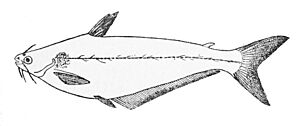African butter catfish facts for kids
Quick facts for kids African butter catfish |
|
|---|---|
 |
|
| Conservation status | |
| Scientific classification |
The African butter catfish (Schilbe mystus) is a type of fish found in many large rivers across Africa. People also call it the butter fish, African glass catfish, or silver catfish. This fish was first described by Carl Linnaeus in 1758.
About the African Butter Catfish
The African butter catfish has a body that looks a bit flattened from the sides. It also has a small, fleshy fin called an adipose fin on its back. This fish can grow up to about 40 centimeters (16 inches) long. It can weigh up to 250 grams (about 9 ounces).
Its head and back are usually brownish. Its belly is a shiny silver-white color. The fins of this fish are mostly clear or colorless. African butter catfish can live for about 6 to 7 years.
Where They Live and What They Eat
You can often find these catfish in calm or slow-moving waters. They like lakes, ponds, rivers, and shallow swamps that have lots of plants. Sometimes, they also live in sandy or rocky streams.
The African butter catfish eats a variety of things. They feed on other fish, insects, and small creatures like crustaceans and snails. They also eat plant material such as seeds, leaves, roots, and even fruit. They are known to eat fish like the Elephant snout and Nile tilapia.
These fish are most active at night or when the light is dim. They reproduce during the rainy season, usually in September and October. They swim into flooded areas and smaller streams to lay their eggs. They often lay their eggs on plants in the water.
Why This Fish Is Important
The African butter catfish is a very important fish for people in many parts of Africa. It is caught and sold as a food fish. Some people also keep them as pets in aquariums.
In northern Africa, these fish face some challenges. Things like dams, water pollution, and dry periods can make it harder for them to survive. However, overall, experts say the species is of "Least Concern" in central, northern, and western Africa. This means they are not currently at high risk of disappearing.
But in eastern Africa, the situation is different. The number of African butter catfish is going down quickly there. This is mainly because of overfishing, which means too many fish are being caught. Because of this, the species is considered "Vulnerable" in eastern Africa. This means they could become endangered if things don't change.


